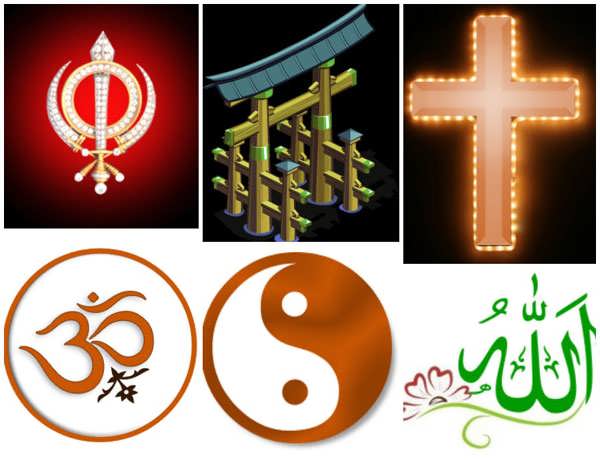Belief in God and faith in a superior being is ingrained in human nature. Throughout the ages, man has submitted to the unknown power that has been credited with the creation of this world. Various Gods and Goddesses believed to control different aspects of our existence have been worshipped in some form or another by all civilizations flourishing across the world. To keep these Gods happy and turn people into good and caring human beings, different religions blossomed, all propagating selfless and righteous living. Over time, symbols came to be employed by the believers in different Gods and faiths to represent their particular religion’s beliefs. Given below are some of the popular God Symbols:
 Christian Cross: Symbolizing Christianity, the cross memorializes Jesus Christ’s crucifixion. It symbolizes the victory of Jesus over death and serves as a reminder to the Christians of God’s love for humanity, for which he sacrificed his own son. Christian Cross: Symbolizing Christianity, the cross memorializes Jesus Christ’s crucifixion. It symbolizes the victory of Jesus over death and serves as a reminder to the Christians of God’s love for humanity, for which he sacrificed his own son. |  Ichthys (Fish): This symbol resembles a fish and is an early Christian representation that stands for Jesus Christ, God’s Son and Savior. Ichthys (Fish): This symbol resembles a fish and is an early Christian representation that stands for Jesus Christ, God’s Son and Savior. |
 Star of David: Named after King David, the Star of David represents the Jewish faith. Known as Magen David or Shield of David in Hebrew, the six-pointed symbol is said to be derived from the shape of the star on King David’s shield. Star of David: Named after King David, the Star of David represents the Jewish faith. Known as Magen David or Shield of David in Hebrew, the six-pointed symbol is said to be derived from the shape of the star on King David’s shield. | 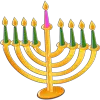 Menorah: Symbolic of the Jewish faith, this six-branched, seven lamp candle-stand stands for universal enlightenment. The central lamp represents the light of God, while the other lamps denote different aspects of human knowledge. The Menorah is also seen as a symbol of creation in 7 days. Menorah: Symbolic of the Jewish faith, this six-branched, seven lamp candle-stand stands for universal enlightenment. The central lamp represents the light of God, while the other lamps denote different aspects of human knowledge. The Menorah is also seen as a symbol of creation in 7 days. |
 Khanda: This Sikh symbol includes a double-edged sword in the middle that stands for faith in one God; a Chakkar (circle) that signifies that God is eternal and has no beginning or end; the two swords on both the sides indicate that spiritual and political powers go hand in hand and one must be ready to fight for what is true as well as what is right. Khanda: This Sikh symbol includes a double-edged sword in the middle that stands for faith in one God; a Chakkar (circle) that signifies that God is eternal and has no beginning or end; the two swords on both the sides indicate that spiritual and political powers go hand in hand and one must be ready to fight for what is true as well as what is right. |  Ik Oankaar: It is the sacred symbol of the Sikhs and denotes the Universal God. It represents the basic Sikh religious tenet that only one Supreme Reality or Power exists. Ik Oankaar: It is the sacred symbol of the Sikhs and denotes the Universal God. It represents the basic Sikh religious tenet that only one Supreme Reality or Power exists. |
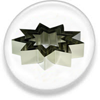 Nine-Pointed Star: The nine-pointed star symbolizes the Bahai faith. The number 9 holds great significance for the Bahai people. This religion is considered by its followers to fulfill the expectations of the different prior religions. The digit 9 denotes completeness and fulfillment. As such, it is seen to be the perfect Bahai symbol. Nine-Pointed Star: The nine-pointed star symbolizes the Bahai faith. The number 9 holds great significance for the Bahai people. This religion is considered by its followers to fulfill the expectations of the different prior religions. The digit 9 denotes completeness and fulfillment. As such, it is seen to be the perfect Bahai symbol. | 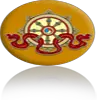 Wheel of Dharma: A prominent Buddhist symbol, the 8-spoke Wheel of Dharma is representative of the noble 8-fold path advocated by Lord Buddha. It symbolizes the endlessness of life and rebirth. The hub of the wheel is symbolic of moral discipline that is required to stabilize the mind, and the spokes stand for wisdom. The rim symbolizes mental concentration, which is a must for holding everything together. Wheel of Dharma: A prominent Buddhist symbol, the 8-spoke Wheel of Dharma is representative of the noble 8-fold path advocated by Lord Buddha. It symbolizes the endlessness of life and rebirth. The hub of the wheel is symbolic of moral discipline that is required to stabilize the mind, and the spokes stand for wisdom. The rim symbolizes mental concentration, which is a must for holding everything together. |
 Om (Aum): The most important of all Hindu symbols, Om represents the three major Hindu Gods. It is also representative of the three worlds – earth, atmosphere, and heaven. When said out aloud, Om is considered a mystical and sacred sound, the greatest mantra. Om (Aum): The most important of all Hindu symbols, Om represents the three major Hindu Gods. It is also representative of the three worlds – earth, atmosphere, and heaven. When said out aloud, Om is considered a mystical and sacred sound, the greatest mantra. |  Swastika: A cross with its four arms bent or branched at 90 degrees; Swastika is a Hindu symbol that is related to auspiciousness and good fortune. It is considered by many to be a symbol representing Lord Ganesha. The word ‘Swastika’ is derived from the Sanskrit language and is interpreted as ‘to be good’ and ‘to be with the higher self.’ Swastika: A cross with its four arms bent or branched at 90 degrees; Swastika is a Hindu symbol that is related to auspiciousness and good fortune. It is considered by many to be a symbol representing Lord Ganesha. The word ‘Swastika’ is derived from the Sanskrit language and is interpreted as ‘to be good’ and ‘to be with the higher self.’ |
 The Star and Crescent: The symbol of the Star and Crescent has come to be associated with Islam, although the religion is supposed to be against using holy symbols. The Star and Crescent: The symbol of the Star and Crescent has come to be associated with Islam, although the religion is supposed to be against using holy symbols. | 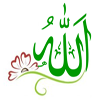 Allah (Calligraphic): Written in the Arabic script, the word ‘Allah’ means God and is considered a visual representation of the Islamic religion. Allah (Calligraphic): Written in the Arabic script, the word ‘Allah’ means God and is considered a visual representation of the Islamic religion. |
 Taiji (Yin and Yang): This Taoist symbol of a circle that contains two swirling sections, white and black, is representative of flawless harmonic balance. It denotes the interdependence and interconnectivity of the opposing forces of the world, which are, in fact, complementary. Taiji (Yin and Yang): This Taoist symbol of a circle that contains two swirling sections, white and black, is representative of flawless harmonic balance. It denotes the interdependence and interconnectivity of the opposing forces of the world, which are, in fact, complementary. |  Torii Gate: A symbol of the Japanese religion of Shintoism, the Torri Gate represents the transition from the finite world to the infinite. It marks the entrance into a sacred space. Torii Gate: A symbol of the Japanese religion of Shintoism, the Torri Gate represents the transition from the finite world to the infinite. It marks the entrance into a sacred space. |
 Ahimsa Hand: This symbol of Jainism represents the vow of non-violence (Ahimsa), which is the pivotal Jain doctrine. The wheel on the human palm symbolizes the Dharmachakra, which involves seeking truth to halt the reincarnation cycle. Ahimsa Hand: This symbol of Jainism represents the vow of non-violence (Ahimsa), which is the pivotal Jain doctrine. The wheel on the human palm symbolizes the Dharmachakra, which involves seeking truth to halt the reincarnation cycle. |  Five-Pointed Star: The five-pointed star is an ancient Christian symbol that represents the birth and reincarnation of Jesus Christ. It is also known as the Epiphany Star and the Star of Bethlehem. The star is a very popular decorative item used for church decoration during festive seasons. The Christian five-pointed star should not be confused with the Wiccan and Pagan ‘Pentagram,’ which is a star formed by five intersecting lines. Five-Pointed Star: The five-pointed star is an ancient Christian symbol that represents the birth and reincarnation of Jesus Christ. It is also known as the Epiphany Star and the Star of Bethlehem. The star is a very popular decorative item used for church decoration during festive seasons. The Christian five-pointed star should not be confused with the Wiccan and Pagan ‘Pentagram,’ which is a star formed by five intersecting lines. |
The various God symbols, such as those given above, help keep the followers close to their God by appealing to their emotions as well as intellect.

